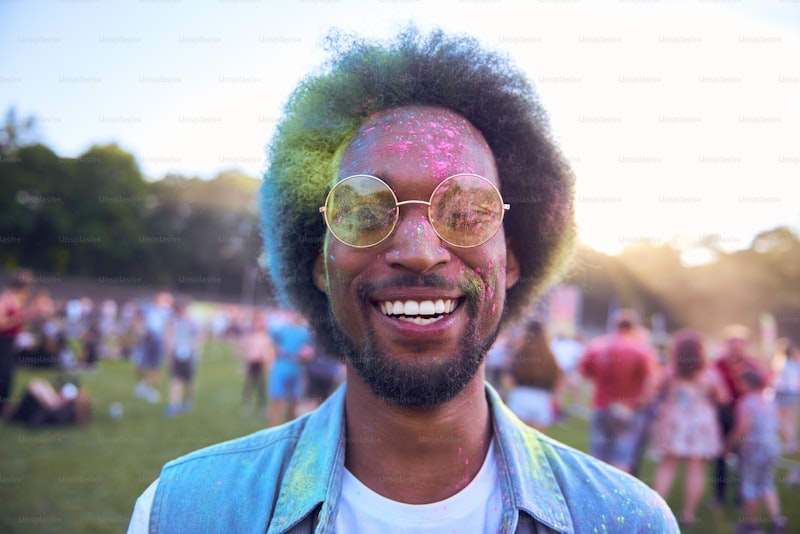Holi is an ancient Hindu festival, which is becoming increasingly popular in the West. It celebrates the advent of Spring with the showering of vibrant powdered colours. Let’s explore the history of this exuberant event and look into how we can incorporate the spirit of Holi into our yoga lessons and practice.
Let the Colours Shower Joy
The main point of Holi seems to be pure, unadulterated joy! In a world constrained by a never-ending ‘to-do’ list, Holi encourages adults and children alike to shed their inhibitions and go wild — literally exploding with colour.
How to ‘colourise’ your yoga class:
- Literally bring colour into your yoga class by treating yourself to some new brightly coloured yoga equipment, such as a new zingy mat. Try yellow, a colour which is uplifting and energising, or orange for gentle creativity.
- Put together a joyful music playlist and inject some energy and light-heartedness into your class.
- Start the class with some child-like poses: balasana or Child’s Pose, Downward Dog, malasana or Happy Baby Pose.
See Also: Eat The Rainbow — Where Does Yellow Fit?
Spring into Spring!
Holi is also called ‘The Spring Festival’ as the explosion of colours is also a reminder of the colour that’s emerging in the natural world, as the grey barrenness of winter is banished by the emerging light and colour of spring, with the promise of summer to come.
How to bring renewed Spring-like growth and vigour to your yoga:
- Get your class working! Throw in some active standing poses at the beginning of the class to get their inner temperature guage turned up a notch. Try Utkatasana, or the three warrior poses to get their blood pumping.
- Tap into the universal prāna (or vital energy) in all of us by incorporating a prānayāma session at the end of your class.
- Try to bring the outside in, maybe by bringing in a jar of daffodils, taking the class outside for a pose or two (weather permitting) or simply by opening up the windows to blow away those winter cobwebs!
A Holi Love-Fest
Holi also celebrates the eternal love between the Hindu deity, Krishna, and his beloved, Radha. The story goes that a young, mischievous Krishna was jealous of Radha’s naturally fair complexion; in India having light skin is very desirable. Krishna’s skin is famously blue, so, encouraged by his mother, he went and daubed colour on Radha’s face, so that she would turn whatever colour he wanted.
This legend gave birth to the tradition of coloured dyes being spread on other people as a reminder of this sweet story. It also resonates with tolerance as it shows that everyone can have skin all the colours of the rainbow – and yet at our core we’re all the same.
It’s important to remember that love is central to yoga. Yoga means union – in other words, love! This can influence everything about our practice: from self-love, to love for others, to love of the subject. It means that we focus on the positive aspects of the practice and those that we are sharing the space with.
How to fill your class with love:
- Incorporate some deep back bends into your sequence. Back bends physically open up the chest and heart area, encouraging us to do so emotionally as well.
- Partner work. When we use each other to move deeper into a yoga pose, we realise that life is better when we work together, rather than in competition.
- Give the students or yourself an extra-long Savasana at the end of the class – a good ten minutes – as a way of showing them that they need to give themselves some love.
See Also: The User’s Guide to the Chakras: the Anahata Chakra
Good vs Bad
The festival was originally called ‘Holika’, after the demon daughter of the evil King Hiranyakashyap. He commanded the whole world to worship only him, but his son Prahlad disobeyed him and continued to be devoted to Lord Naarayana.
To punish his son the King tried to kill him by sending him into the middle of a burning inferno with his sister, who was supposed to be immune from the effects of fire due to a boon. However, the god Vishnu saved the young boy from the flames, while his sister perished in the fire; her boon became invalid because she had used it with the intention of taking another’s life.
To celebrate this rather grisly story, bonfires with ‘Guy Fawkes’-style Holikas are burnt to begin the Holi festival. This myth is now seen as symbolic of ‘starting afresh’ as we burn away our bad habits with the Holika and get new energy and good habits in their place.
Burn away bad habits in your yoga class:
- Twist away bad posture with a twists-focused class. By lengthening our spines and giving our internal organs a good wringing out we’ll rejuvenate our inner organs and get a new flush of energy.
- Mix things up! Try to break bad habits by second guessing your students. Get them to change the cross in their legs, go to the wall if they don’t usually, go back to basics, or step outside their comfort zone.
- If you’ve been struggling with keeping up a home practice, pick a pose (just one) and practice it every day without fail. Once that’s in place you can expand your practice but at least that way you know you can do it.
Group Hug
Another key element of the Holi festival, which is in common with many national days of celebration, is that it’s a chance to step off the treadmill of our busy lives and enjoy simply getting together.
During Holi day amidst all the colour and chaos, friends, families and total strangers hug each other and wish each other a ‘Happy Holi’. So, to celebrate the spirit of human togetherness, share in this tradition by ending your yoga class with a group hug and join in with the global Holi day.
See Also: Light in the Darkness: How Yoga Got Me Through My Grief













